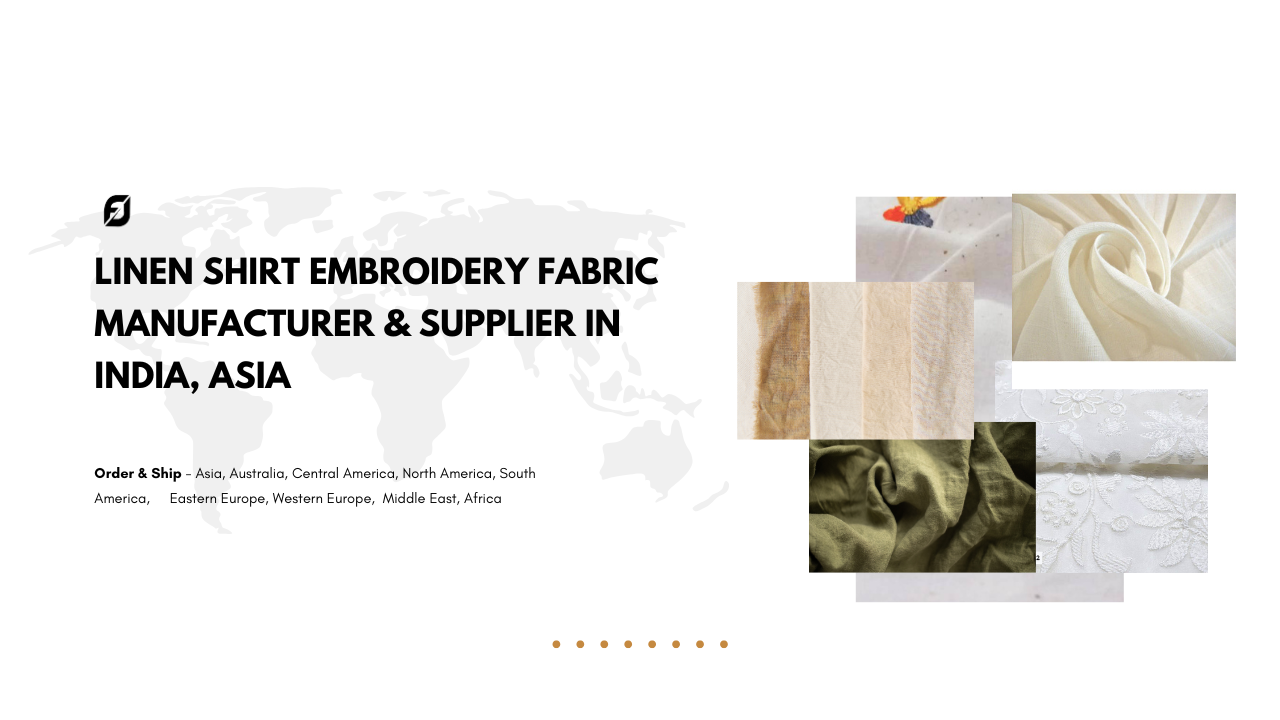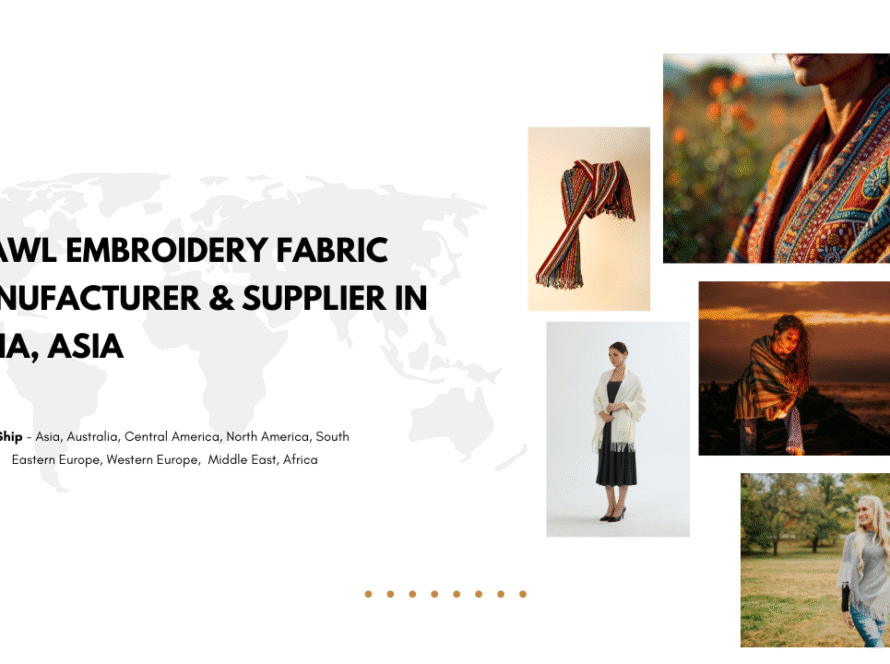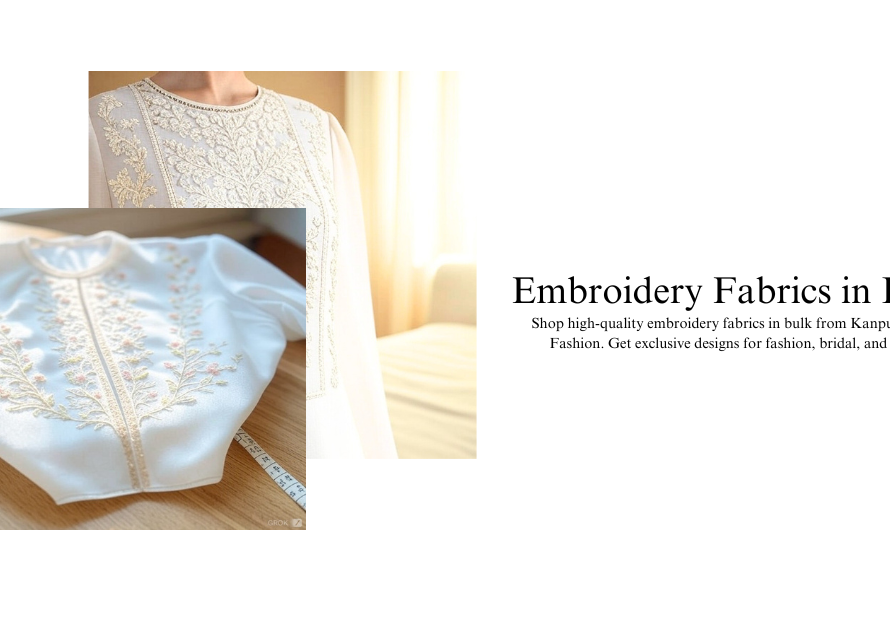Chiffon embroidery fabric stands as a timeless icon in the realm of haute couture, renowned for its ethereal charm and versatility.
This exquisite fabric has carved its niche in the global fashion arena, with India playing a pivotal role in its popularity.
Why Chiffon Embroidery Fabric is a Top Choice for Apparel in India”
Let’s delve into what makes chiffon embroidery fabric a coveted choice and explore its distinct variations—embroidery, digital print, and plain RFD (Ready for Dyeing)—and the garments they inspire.
Understanding Chiffon:
Chiffon, characterized by its lightweight and sheer texture, is crafted from silk, synthetic fibers, or a blend thereof. It drapes gracefully, making it ideal for creating flowing silhouettes that exude sophistication and allure. Its airy nature lends itself beautifully to both casual and formal attire, making chiffon a staple in designers’ collections worldwide.
Types of Garments Made from Chiffon Fabric:
- Chiffon Sarees: A quintessential favorite, chiffon sarees epitomize elegance. They are favored for their fluidity and ability to enhance the feminine silhouette, making them a preferred choice for weddings, parties, and festive occasions.
- Chiffon Dresses and Gowns: Whether it’s a cocktail dress or an evening gown, chiffon adds a touch of glamour. Its lightweight feel and graceful fall make it perfect for creating flowing skirts and layered dresses that sway with every movement.
- Chiffon Kurtis and Tunics: Embraced for their comfort and chic appeal, chiffon kurtis and tunics are popular in both casual and semi-formal settings. They often feature intricate embroidery or digital prints that elevate their aesthetic appeal.
Distinguishing Chiffon Embroidery, Digital Print, and Plain RFD Fabric:
- Chiffon Embroidery Fabric: Adorned with intricate thread work, chiffon embroidery fabric showcases craftsmanship at its finest. It often features motifs, floral patterns, or intricate designs meticulously embroidered onto the delicate chiffon base, adding texture and depth.
- Chiffon Digital Print Fabric: Digital printing on chiffon allows for vibrant, detailed designs with endless color possibilities. This technique enables designers to create bespoke prints ranging from floral motifs to abstract art, catering to diverse aesthetic preferences.
- Chiffon Plain RFD Fabric: Ready for Dyeing (RFD) chiffon fabric serves as a blank canvas for creativity. Designers can customize it by dyeing it in various hues, transforming it into personalized creations that reflect individual style.
Why Chiffon Embroidery Fabric is Famous in India:
Chiffon embroidery fabric has earned acclaim in India for several reasons. Its delicate texture complements the country’s rich cultural heritage, where intricate embroideries like zardozi, chikankari, and thread work find profound appreciation. Chiffon sarees embellished with such craftsmanship are cherished for bridal wear and traditional celebrations, embodying timeless elegance with a modern twist.
Madhav Fashion and Chiffon Embroidery Fabric:
As one of Asia’s leading embroidery fabric manufacturers, Madhav Fashion exemplifies innovation and quality. While confidentiality agreements prevent naming specific brands, Madhav Fashion’s chiffon embroidery fabrics grace top-tier fashion events, celebrity wardrobes, and silver screens worldwide. Their designs captivate fashion enthusiasts who appreciate superior craftsmanship and impeccable quality.
chiffon embroidery fabric transcends borders, blending tradition with contemporary style. Its allure lies not only in its delicate beauty but also in its ability to transform ordinary garments into extraordinary pieces of wearable art. As fashion evolves, chiffon remains a timeless favorite, celebrated for its sheer elegance and versatility.
_________________________________________________________
1. What makes chiffon embroidery fabric unique compared to other fabrics?
Chiffon embroidery fabric stands out for its lightweight, sheer texture combined with intricate threadwork designs. Unlike heavier fabrics, chiffon drapes effortlessly, giving garments an elegant and flowing look. Its delicate structure allows the embroidery to add dimension without overwhelming the fabric. This perfect balance between fragility and beauty makes it ideal for formal wear, such as sarees, gowns, and lehengas.
In comparison to denser fabrics, chiffon embroidery offers a breezy feel, making it comfortable for extended wear, especially in warm climates like India. The embroidery work—whether traditional Indian motifs or modern designs—elevates the fabric’s aesthetic appeal, adding visual richness. This ability to combine fluidity with intricate craftsmanship is what gives chiffon its enduring charm, making it a favorite among designers and wearers alike.
Additionally, chiffon’s versatility in taking on vibrant dyes, prints, or metallic threads means it can be styled in endless ways. From soft pastel bridal wear to bold, statement-making evening gowns, chiffon embroidery fabric brings timeless elegance and a touch of luxury to any wardrobe, setting it apart from other fabrics in fashion.
2. What types of garments can be made from chiffon embroidery fabric?
Chiffon embroidery fabric is highly versatile, lending itself to a variety of garments that require elegance, movement, and a luxurious touch. One of the most popular garments made from this fabric is the chiffon saree. Chiffon sarees with intricate embroidery are favored for weddings, festivals, and formal events due to their lightness and sophisticated appeal.
In addition to sarees, evening gowns and cocktail dresses crafted from chiffon embroidery fabric exude glamour. The fabric’s soft drape makes it ideal for flowing, layered skirts and delicate detailing, perfect for high-end occasions like red-carpet events, weddings, or formal parties.
Chiffon embroidery is also used for kurtis, tunics, and blouses, adding a touch of intricacy to casual and semi-formal wear. The breezy fabric ensures comfort while the embroidery enhances the visual appeal. Moreover, lehengas and dupattas made from chiffon with detailed threadwork are popular choices for festive and bridal wear.
Chiffon’s lightweight feel makes it ideal for garments that need to move gracefully, while its embroidery adds the perfect finishing touch of luxury and refinement.
3. Why is chiffon embroidery fabric so popular in India?
Chiffon embroidery fabric has gained immense popularity in India due to its blend of comfort, tradition, and elegance. The fabric’s lightweight nature makes it ideal for the Indian climate, where breathable materials are often preferred. Chiffon’s sheer, airy feel keeps wearers cool while offering an elegant drape, perfect for both casual and formal occasions.
In India, there’s a rich heritage of intricate embroidery work, and chiffon serves as an excellent canvas for showcasing traditional art forms like zardozi, chikankari, and resham. The detailed threadwork brings a regal touch to the fabric, making chiffon embroidery sarees and lehengas popular choices for weddings, festivals, and religious ceremonies.
Furthermore, chiffon’s versatility allows it to be used across various types of garments. Be it a stunning bridal saree, a designer kurti, or an embroidered dupatta, the fabric enhances the appeal of traditional Indian attire. Its lightweight texture makes it comfortable for extended wear, while the embroidered patterns add richness and cultural depth to any garment.
Chiffon embroidery fabric offers the perfect combination of modern fashion sensibilities with traditional Indian craftsmanship, making it a favorite among Indian designers and fashion enthusiasts.
4. What is the difference between chiffon embroidery fabric, digital print chiffon, and plain RFD chiffon?
Chiffon fabric comes in different forms, each serving unique purposes in fashion design. Chiffon embroidery fabric is embellished with intricate threadwork, adding texture and depth. The embroidery can feature traditional designs, floral patterns, or modern motifs, transforming simple chiffon into a luxurious fabric perfect for high-end garments like sarees, lehengas, and gowns.
Digital print chiffon, on the other hand, focuses on bold, vivid designs printed directly onto the fabric. This method allows for detailed, multicolored patterns, from florals to abstract prints, and is popular for casual wear like kurtis, scarves, and dresses. Digital printing offers endless customization options in terms of color and design, making it a popular choice for fast-fashion and personalized clothing.
Lastly, plain RFD chiffon (Ready for Dyeing) is a neutral base fabric that can be dyed into any color, making it highly customizable. It is often used by designers as a canvas to experiment with different shades or as the foundation for adding further embellishments like embroidery or prints.
Each type of chiffon has its own strengths, allowing designers to choose based on the desired aesthetic and garment type.
5. Can garments be made from all three types of chiffon fabric—embroidery, digital print, and plain RFD?
Yes, garments can be made from all three types of chiffon fabric—embroidery, digital print, and plain RFD—depending on the desired design and style. Each version of chiffon fabric brings a unique flair to the garments.
- Chiffon embroidery fabric is ideal for high-end, formal attire like sarees, gowns, and lehengas. The intricate threadwork elevates the fabric, making it perfect for special occasions such as weddings or evening events.
- Digital print chiffon is more casual and versatile. The digitally printed designs range from subtle to bold, making it suitable for kurtis, dresses, scarves, and tops. Digital print garments often cater to fast fashion trends due to the vibrant patterns and ease of production.
- Plain RFD chiffon is used as a base fabric for dyeing and can be transformed into any color or shade. Designers often start with plain chiffon to experiment with different dyes, prints, or even add embellishments like sequins or embroidery. Plain RFD chiffon is also suitable for making dupattas, blouses, or layered skirts, especially in its dyed form.
In essence, all three types offer versatility and can be tailored to meet the specific needs of any fashion collection.
6. Why are chiffon sarees so popular in India?
Chiffon sarees have become a symbol of grace and sophistication in India, gaining widespread popularity for several reasons. First and foremost, chiffon’s lightweight and sheer texture makes it perfect for the Indian climate, where heavy fabrics can feel uncomfortable, especially during long hours of wear. Chiffon sarees allow for easy movement and breathability, making them ideal for weddings, parties, and festive events.
Chiffon’s drape quality is another reason for its widespread appeal. The fabric clings to the body in a flattering way, enhancing the natural silhouette without adding bulk. This makes chiffon sarees especially popular among women who want to achieve an elegant and slender look.
Moreover, chiffon sarees can be heavily embellished with embroidery, sequins, or digital prints, offering a wide range of options for different occasions. The fabric also pairs well with intricate blouses, further enhancing the overall appeal.
The combination of comfort, versatility, and elegance has made chiffon sarees a must-have in every woman’s wardrobe, ensuring their enduring popularity across generations in India.
7. How is Madhav Fashion involved in creating chiffon embroidery fabric?
Madhav Fashion, one of the largest embroidery fabric manufacturers in Asia, plays a pivotal role in producing chiffon embroidery fabric. Their expertise in creating high-quality, intricate embroidery designs on delicate chiffon sets them apart in the global market. From traditional Indian embroidery like zardozi and reshaam work to contemporary designs, Madhav Fashion’s craftsmanship caters to diverse fashion needs.
Madhav Fashion’s chiffon embroidery fabrics are widely appreciated for their attention to detail and superior quality. While they are associated with top global brands and fashion houses, confidentiality agreements often restrict them from revealing specific collaborations. However, their fabrics can be seen in high-profile fashion shows, movies, and even on celebrities, where their signature designs are recognized by those familiar with their work.
In addition to embroidery, Madhav Fashion also offers customization services, allowing designers and brands to create unique patterns and motifs that align with specific design concepts. Their chiffon fabrics are not only popular in India but also exported to international markets, further establishing their reputation as a leading manufacturer in the industry.
8. What are the benefits of chiffon embroidery fabric for formal occasions?
Chiffon embroidery fabric is highly sought after for formal occasions due to its combination of elegance, comfort, and visual appeal. The lightweight nature of chiffon makes it ideal for garments that need to be worn for extended periods, such as weddings, parties, or formal gatherings. Unlike heavier fabrics, chiffon allows for ease of movement while maintaining a sophisticated, flowing appearance.
The embroidery on chiffon fabric adds a touch of luxury and refinement. Intricate designs, often featuring traditional patterns or delicate floral motifs, enhance the overall look of the fabric, making it perfect for sarees, lehengas, and gowns. The embroidery adds texture without overwhelming the fabric’s natural grace, making chiffon embroidery garments look regal yet understated.
Moreover, chiffon’s sheer and drapable qualities create a flattering silhouette, allowing it to be used in layered skirts, flowing gowns, and elegant sarees. This fabric is particularly favored for evening wear and bridal attire, where both comfort and elegance are key.
In essence, chiffon embroidery fabric strikes the perfect balance between beauty and practicality, making it a top choice for formal events.
9. Can plain RFD chiffon be customized for designer garments?
Yes, plain RFD (Ready for Dyeing) chiffon is highly customizable and serves as an excellent base for creating unique designer garments. Since RFD chiffon is undyed, it offers endless possibilities for designers to experiment with different colors, shades, and even embellishments. Designers often start with plain chiffon and then dye it to the exact color required for their collection.
In addition to dyeing, RFD chiffon can be embroidered, printed, or embellished with sequins, beads, or lace, making it versatile for a wide range of garments. Whether creating elegant sarees, lehengas, gowns, or kurtis, RFD chiffon allows for complete creative freedom.
For brands and designers looking to create custom garments, RFD chiffon serves as the perfect blank canvas. It can be tailored to meet specific aesthetic requirements, from soft pastel bridal collections to bold, vibrant festival wear. The fabric’s sheer, lightweight quality also makes it ideal for layering and draping, adding to its versatility.
At Madhav Fashion, plain RFD chiffon is offered as part of their customization services, allowing designers to craft exclusive, one-of-a-kind pieces for their clients.
10. How can digital print chiffon fabric be incorporated into modern fashion trends?
Digital print chiffon fabric is a game-changer in the world of fashion, offering endless opportunities for innovation and creativity. Unlike traditional prints, digital printing allows for vivid, detailed patterns that can range from soft florals to bold geometric designs. The technology enables designers to experiment with complex prints and color combinations that are hard to achieve with conventional printing methods.
Incorporating digital print chiffon into modern fashion trends allows for creating unique, eye-catching garments. Flowy maxi dresses, bohemian blouses, and stylish sarees made from digital print chiffon are ideal for both casual wear and special occasions. The bold prints make a statement, while the sheer, lightweight chiffon fabric ensures comfort.
In contemporary fashion, digital print chiffon is often paired with minimalist silhouettes, where the fabric’s bold prints are allowed to shine. It is also used for creating fusion wear, blending traditional designs with modern cuts and styles, such as digitally printed lehengas with crop tops or digital print scarves for a casual chic look.
As fashion trends move towards individuality and customization, digital print chiffon fabric offers a fresh, modern twist, making it a must-have in any designer’s repertoire.






